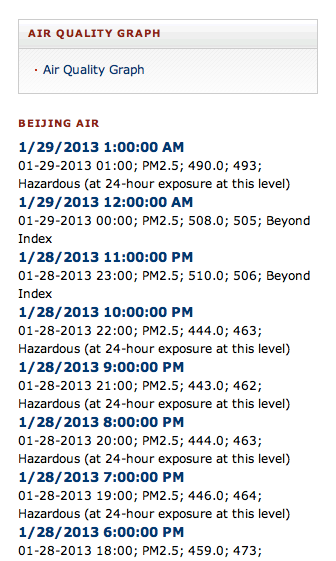Air pollution is mostly invisible – consisting of gaseous molecules and particles too small to be seen. Therefore you may not be aware of what you are inhaling, sometimes deep into the lungs and even the bloodstream. When air pollution gets as bad as Beijing's air pollution, that you can actually see it - as a haze or smog - then exposure is going to cause both severe short and long-term health problems. That is why China will be paying with the health of its population for its economic growth.
Accurate Reporting on Beijing's Air Pollution
Recently the BBC highlighted the problem of Beijing's Air Pollution, noting that observers said the air actually tasted of coal dust and visibility was limited by smog. There was no escape from Beijing's air pollution, for even the indoor air pollution was so high that there is a hazy in your home. At the same time, the air quality monitor at the US Embassy reported Beijing's air pollution levels rocketing of PM2.5s. These are tiny particles (with a size of 2.5 microns or less). The World Health Organization considers that levels over 25 micrograms per cubic metre pose an increasing health hazard. Beijing's air pollution levels were over 400 micrograms per cubic metre at the time the BBC made its report.
Research has shown that exposure to PM2.5s is linked to the following health impacts:
- Premature mortality
- Exacerbation of existing heart and lung disease (increased hospital admissions, visits to the emergency room, sick days off work)
- Asthma attacks
- Heart attacks
- Abnormal heart rhythms
These adverse effects occur because the small size of PM2.5s means they can be inhaled deep into the lungs and may even enter the bloodstream, causing inflammation. Children and older people, as well as those with pre-existing heart or lung disease, are more at risk of the hazards associated with PM2.5s.
The particles in Beijing's air pollution are produced by combustion and by various industrial processes. The link with China's industrial and economic growth is obvious. Unfortunately, the authorities have not taken on board the idea that industrial activity unrestrained by strong environmental legislation will only undermine the nation by taking a severe toll on the population's health.
It may well be that the very public exposure of Beijing's air pollution record may provide a push for change. The US Embassy has been publishing hourly PM2.5 data for some time now. When I checked just now (28th January - see picture), levels were consistently well over the 400 micrograms per cubic metre danger level. The Chinese authorities have apparently been critical of the Embassy for publishing Beijing's air pollution data because they say it may not be representative of the city as a whole, or of China as a whole. In fact, the Ministry of Environmental Protection does publish its own data but here it is not possible to check Beijing's air pollution PM2.5 levels as easily as on the US Embassy site. The Chinese authorities need to look at ways of controlling both industrial processes and the traffic that comes with economic growth to bring their air quality in line with that of other developed countries around the world where environmental legislation is properly enforced.




